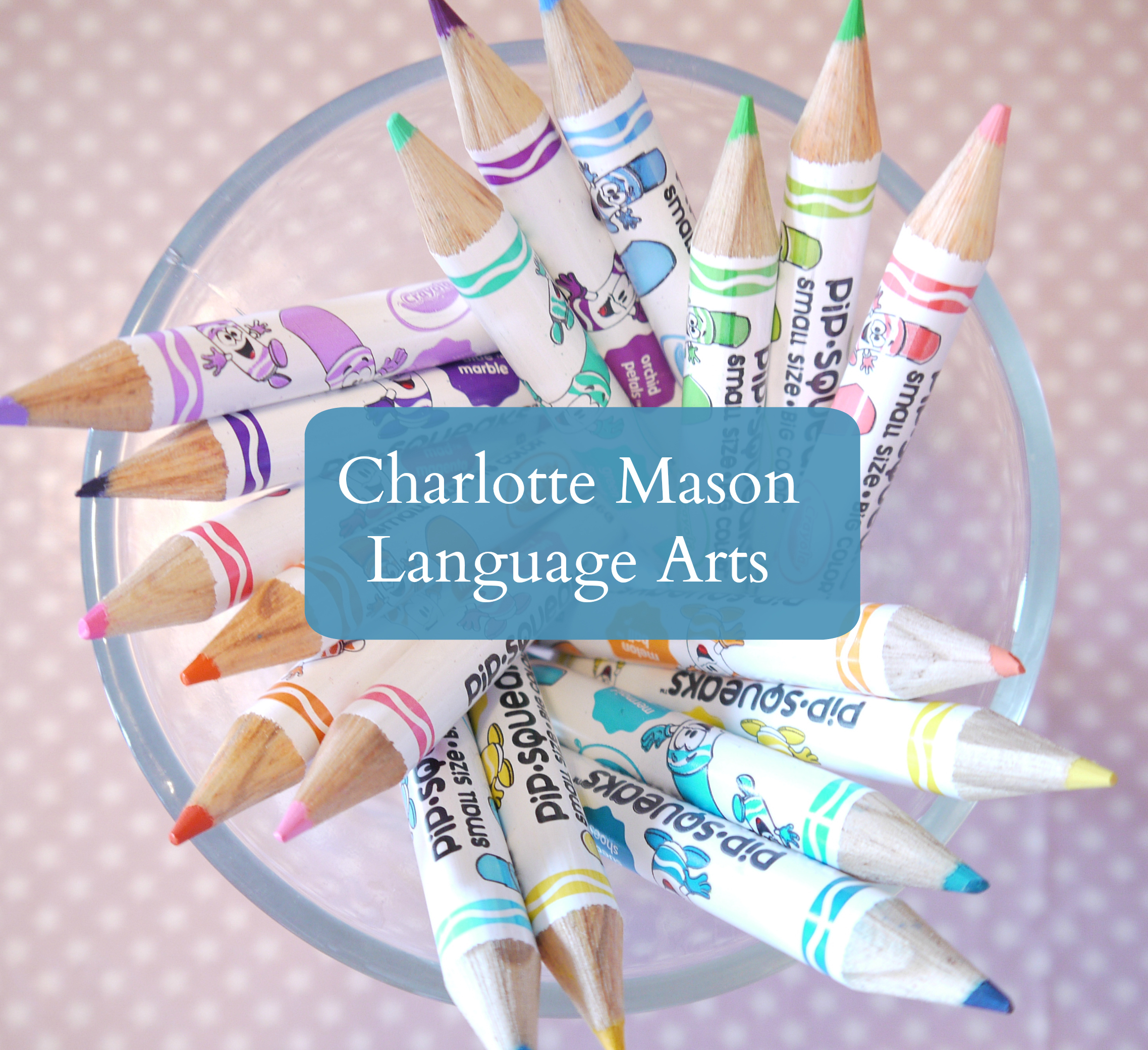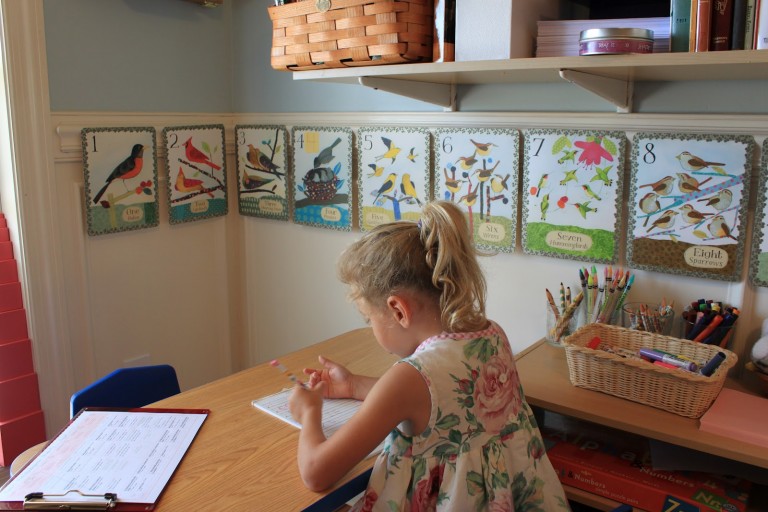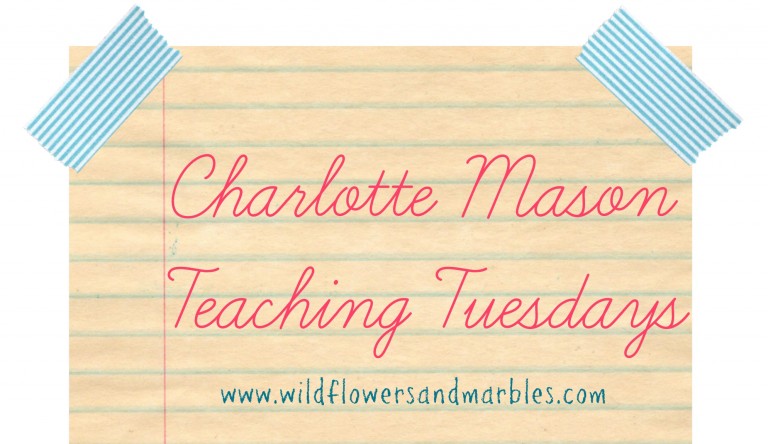Considering Language Arts – Narration
I started my series on our approach to language arts, and realized that our approach, while not contrived or complicated, did contain a fair amount of *meat*. I didn’t want to cram it all into one long post and lose you, so this is the second part in my series covering narration.
An integral part of our language arts approach is the narration. Narrations can be oral or written, but in this post I’m going to discuss how we approach the oral narration because it is such a solid feature of my days that it cannot be dispensed with. As I think back on my years of home education, without a doubt, some of my favorite memories are thoughts, impressions, and delights shared through narrations.
My young learners are not required to narrate – only those children 6 and above! Carving time out of the day to listen to narrations can be challenging, but I make it a priority! I couple this priority with fostering the good habit of not interrupting for the other children!
Please don’t envision perfectly quiet, idyllic narration times here! We have our share of interruptions from little people, and I do my share of juggling to carve out the time for narrations. However, once you lay down the habit of narration as well as the habit of politeness for those not narrating: not interrupting, speaking with a quiet voice, waiting your turn with the littles (admittedly, these are all biggies that require patient and gentle consistence, but you’ll NEVER be sorry you spent the time working on them!) you’ll find these narration times to be among your most cherished treasures!
Narration – is simply this: the child telling back in their own words after reading something. Charlotte Mason had this to say about narrations (Volume 6, p.260 – 261):
“Give a book of literary quality suitable to their age and children will know how to deal it without elucidation…they will be able to tell you the whole thing with little touches of individual personality in the narrative. (T)elling again sounds very simple but it is really a magical creative process by means of which the narrator sees what he has conceived.”
There is an ownership which takes place as the child tells you what they read. Their enthusiasm and excitement are often conveyed in their retelling. Not every narration is a jubilant expression of the words on the written page; some narrations are simply summaries, and that’s just fine! An example of a book which inspires an eager re-telling in our home would be something from Arthur Ransome’s Swallows and Amazons series. These have to rank among some of the best children’s literature of all time! However, some books must be read and narrated as a matter of discipline. A healthy, balanced meal is the most nourishing, and some of that balance may come from choices that aren’t necessarily the child’s favorite “comfort foods”, but the food is nourishing none-the-less. Not everything can be written as if from the pen of Arthur Ransome. Of course, my 13 year old would retort, “and, why not?!” LOL!!!
So, from a variety of living books, the children narrate. Don’t overcomplicate this! It’s simple and intuitive. Read a book – retell it. Let’s get to the good stuff!
How much reading do you assign before asking for a narration?
That depends on the age of the child, their reading abilities, and how much of the habit of attention the child has acquired. Ask a child, any child, to narrate too much and you’ll end up with a very overwhelmed, frustrated child, and you will begin to question the entire method. It’s easily fixed though.
First, ensure that you’ve asked the child to read and narrate from a living book (I’ve noticed that narration has caught some non-living books I’ve asked my children to read….a child has a very hard time narrating them because he doesn’t have an opportunity to develop a relationship with the thoughts!)
Next, start with reading aloud. I like to start with Aesop’s Fables, but anything with short little chapters will work here. Read and ask for a re-telling. Do they seem overwhelmed? Unable to remember anything? Frustrated? Don’t push! Can you ask a simple question to get the ball rolling? Try to ask something open ended. Close the book for the day and try again tomorrow. Read a little less if needed….maybe just a paragraph. Ask your child to narrate. Can they remember what you just read from the short paragraph? Yes! Great! Praise them and read another paragraph! Narrate again! Read only once – you’re building the habit of attention. If needed, work up to a full chapter or short story, but start small enough that you can build on success.
In general, my elementary aged students can narrate a short chapter’s reading at a time. I try to provide time to narrate right after reading.
Middle school students do well with narrating and summarizing 1 – 2 chapters worth of information at a time. They no longer need to narrate immediately after reading if they’ve been narrating for several years. By now, they have a well developed habit of attention, and can narrate later in the day.
I only have one high schooler so far, so do check out some other blogs for more experience there (Barb at Harmony Art Mom has a great post). At this point, my high schooler has been at this for a while and can narrate at the end of the day or even the next day all that she read for the day. She can narrate more than one chapter of information and summarize well at this point. Sonya Shafer, in her All Day Charlotte Mason Seminar, mentions that her high schooler can narrate an entire units worth of information in one narration.
How do you ask for a narration?
Read aloud, or after the child has read independently, ask them to tell you what they just read about. You don’t have to say, “Please narrate that fable to me, little Johnny.” I like to say, “Wow, that was a great story! What can you tell me about it?” Or you could ask another open ended starter question, “Who was your favorite character?” “Did you catch that part about the bee?” Be interested. Engage your child! Your interest is generally all that is needed to motivate your narrator. Stay engaged and focused as much as you are able.
How long is a narration?
Each child has a different style of narrating, so there’s no right or wrong way to narrate, there isn’t a “minimum length.” The idea is a re-telling in the child’s own words. Some boys are natural summarizers. I think my brother was probably this way. My mom would tell me that his narrations were extremely succinct and to-the-point. If you have a child with a photographic memory, you may have to help that child summarize more by modeling through your own narrations.
How many books a day do your children narrate?
Not every book around here is narrated! Some books are just for enjoying without a narration! Unless a read aloud is for a specific subject, I don’t ask for a narration.
My older children narrate living books on science, history, literature, and religion. I include a reminder on their lesson plans to let my child know that I expect a narration of that reading. It looks something like this:
The Chemical History of a Candle by Michael Faraday
Lecture 2
O Narration
Now my child knows that a narration is expected after a reading, and the prompt helps keep me accountable.
We make time for narrations in various ways:
- During quiet-time or naptimes (I strictly enforce quiet time for my 6 yo and younger crowd! This time is treasured by my older children and I. We have our tea-time in the afternoons during quiet time, and this is their favorite time to offer narrations…while we sip tea or lemonade together!)
- In the car on errands
- While making dinner
- While folding clothes or taking a walk
- Older children watch or work with younger children while another child narrates
- Toss small children in a dry bathtub (containment is your friend!) with a few special toys – that gives you at least 15 minutes!
- Keep a basket of special treasures tucked near your desk to pull out when needed. These are just for short re-directs while I need to give quiet focused attention to my narrator. I have a small basket of:
- plastic magnifying glasses
- toy telescopes
- kaleidoscopes – big
and small
- tiny notebooks and pencils
- a collection of stickers and mini-books I make from cardstock – I like this alphabet and numbers sticker collection
- wooden animal figures and a tiny plastic fence
- finger puppets
– a select few
- tiny found treasures – piece of string, cotton puff, aluminum foil goblets, little wooden miniatures
- plastic magnifying glasses
What does the narration cover in language arts?
- Reading comprehension – once the child tells back, you know if they understood or not. No reading comprehension questions needed!
- Organization of thought – this naturally lays the groundwork for writing!
- Summarization skills – a progression from super-detailed narrations toward good summaries happens naturally as the child gets older. Observation of great detail is a wonderful skill and I absolutely don’t discourage it. When my oldest (who has a near photographic memory) started working on written narrations, the progression from uber-detailed narrations to summary happened naturally as we looked together at thoughts on paper and began to discuss how to narrow thoughts and summarize.
- Oral communication skills
- Analysis and opinion – older children begin to offer more and more of their opinions during narration. Narrations lead very naturally into rich discussions with my older children.
- The habit of attention. The child reads once and only once and should be able to tell back – narrate – from that one reading! This builds in children the habit of attention!
That’s a lot of bang for the buck with one narration! Make it a priority and don’t dismiss the value of a narration! It’s a precious time spent together, and so worth the investment spent carving out the time needed!
Rules for me during a narration
- No cognitive multi-tasking. I do fold laundry, do dishes, stir the pot, etc….but no computer multi-tasking, no reading, no engaging two speakers at once. Anything that keeps me from engaging my child is not allowed!
- No interrupting. I do sometimes ask questions at the end of a narration if I need clarification, and if a child is stumped I might ask a general question to get them rolling.
Don’t forget the Narration Cube to help out with group narrations after a read aloud!
Edited to add a link to resource review post on Karen Andreola’s book, Story Starters. This book is a wonderful resource for narration!
Looking for more? There is so much to turn over and think about at Lindafay’s blog, and so much practical wisdom: Higher Up and Further In – Narrations. Lindafay compiled many of her wonderful posts into a website – you might find them easier to navigate than the blog: Charlotte Mason Help: Narration. Happy reading!
Next up in the series….Copywork!








Wonderful, Jen. Do you require both an oral narration and a notebook page/written summary of every chapter when it comes to your older kids? Or do you alternate? I'm leaning towards alternating for my dd11, as I don't want to overwhelm her with writing.
I don't think I have ever posted before but I read every post with interest. I have learnt a lot from you!
I have one question though – it seems that you read the passage/chapter etc but narrate it later. Ordinarily, if a child was doing a boring text book comprehension it would be an immediate thing – read the passage and answer these questions. How long do you wait between reading and narrating, or is it tailored for each child?
I am going to try this with my daughter who has a processing disorder over the summer. I think narration would be the most helpful thing I have ever heard of – far better than the boring exercises we have been given.
Thank you
Another fabulous post, Jen! Thanks!
What good information!
I have an award for you over on my blog!
http://musicalmama08.blogspot.com/2010/07/good-and-bad.html
How often do 'you' write down their narrations?
Let's get to some questions!
Paula asked:
>> Do you require both an oral narration and a notebook page/written summary of every chapter when it comes to your older kids? Or do you alternate? << I alternate, Paula. And, when we transition into a new writing skill, I am careful not to overwhelm so I think you're very wise on that approach!
Annicles asks:
>> I have one question though – it seems that you read the passage/chapter etc but narrate it later. Ordinarily, if a child was doing a boring text book comprehension it would be an immediate thing – read the passage and answer these questions. How long do you wait between reading and narrating, or is it tailored for each child? << This really depends on the child and their age/ability a lot! For an early elementary child – we read together and then I ask that child to narrate immediately afterward. I have a 5th grader that is a very strong reader; he can narrate several hours after he reads a selection. If you're just starting to ask for narrations, I'd try narrating close to the reading to really lay down the habit of attention and to help build narrating skills. After you do this for a bit, you'll begin to get a feel for your child's abilities. Watch for signs of frustration — if you sense them, drop either the amount read and narrated, or move the narration closer to the reading. Move gently and slowly so as not to overwhelm all at once. Hope this helps!
Erin wants to know:
>> How often do 'you' write down their narrations? << Everyone does this differently. I know some moms transcribe their kids narrations for them. One friend of mine shared with me that she created individual (private) blogs for each of her children and that's where she records their narrations. I thought that was a fantastic idea because you could also keep up with the books they are reading/have read! Confession: I don't transcribe narrations until a child is moving from oral narrations to written narrations. It is just so helpful to do this for a child so that they begin to see the level of detail, and it's such an amazing way to help them begin to summarize and further organize their thoughts. I print the transcription double spaced. The child cuts out the sentences and then re-arranges in a way that makes more sense. That's it for my transcriptions. 🙂
Thank you all for the great questions and kind words and awards! 🙂
Really enjoying all you have to say – thanks for doing it. We narrate and I love the approach.
Hi Jen,
haven't had chance to read your last two posts yet…. waiting until I have the time to do them justice!! just wanted to contact you and say “saw these and thought of you”……
http://www.thatresourcesite.com/montessori_literature_burgess_bird.htm
hope they are useful if you haven't already got them!!
best Wishes, Jenni
Jenni,
You're great! I'm so glad you're watching out for us! I DO have them, and I'm using the cards as part of my reading along with Burgess' book! They're lovely!
Thank you so much for your post! I havent' done much with narrations with our 7 year-old, he gets frustrated with summaries, but can answer specific questions almost verbatim from the book. When you said
“If you have a child with a photographic memory, you may have to help that child summarize more by modeling through your own narrations.”
It clicked that *that* was the problem. He does have a nearly photographic memory! I'm going to try this out and I think it'll really help!
And I love your idea for the transcriptions!
Thanks so much for all the inspiration and for opening your school room doors to us!